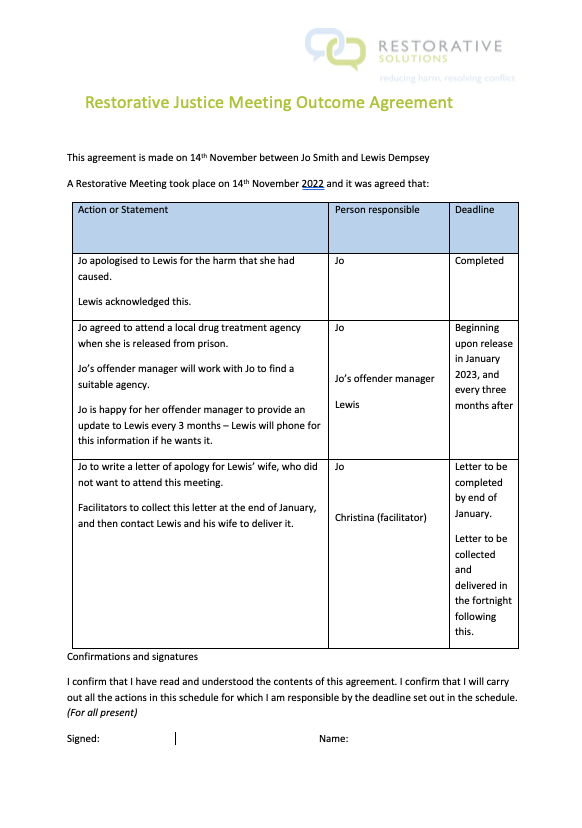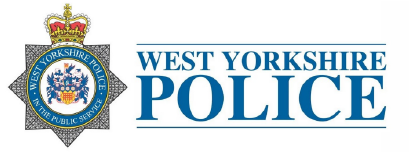What happens in a Restorative Justice meeting?
Posted on: 28th, April 2023
Meetings can be a part of the Restorative Justice process, a voluntary service that helps victims of crime and offenders to come into communication in a safe, facilitated environment. The purpose of Restorative Justice is to help victims move on in a healthy way that they have control of, and provide the opportunity for them to ask the offender any questions they may have about the crime. In one Restorative Justice case, John had burgled Lucy’s home, and Lucy identified specific questions she wanted answers to; “Were you watching me? Are you sorry for what you have done? What are you going to do when you are released from prison?” Getting answers to these questions meant Lucy felt able to move on from the crime.
Restorative Justice can also show the offender how the crime has impacted the victim, and encourage them to take responsibility for their actions. Following the meeting, John said, “The effect of the conference has certainly changed me as a person. I had never taken into consideration how people really felt from my crimes and this is a huge wake-up call for me. The Restorative Justice process has made me really think about the consequences of my actions.”
In this article, we’ll address how a face to face meeting between both parties might look when a direct Restorative Justice approach is taken. It’s important to note that indirect methods of Restorative Justice are also available, if the participants are unwilling or unable to meet with their offender in-person.
What happens before a Restorative Justice meeting?
Restorative Justice facilitators undergo prep-work with everyone involved before the victim and offender meet. This can include creating a script to establish what will be discussed. The script could cover topics such as the victim’s preferred language when describing the crime, or whether they feel comfortable discussing the details of the event. A script can be beneficial in managing expectations of the meeting, and help both victim and offender feel prepared. However, if the participants feel that a script isn’t necessary, a flexible discussion approach is available.
In pre-meeting discussions with Restorative Justice facilitators, victims can also decide how much support they would like from facilitators during the meeting. By understanding the contribution and role of the facilitator, it can help the victim feel more confident. A victim of burglary, who was supported by the facilitators throughout the meeting, valued their “professional approach and friendliness.”
Where does a Restorative Justice meeting take place?
If the offender is serving a custodial sentence, the Restorative Justice meeting will take place in the prison. The victim would never have to enter the prison wing; instead, a multi-faith centre or admin room could be used – somewhere where the meeting is unlikely to be disturbed. The victim has the option to visit the prison before the meeting, to experience the security process, and become familiar with the meeting room layout. This allowed Elizabeth, a victim of assault, to feel more prepared when meeting her offender, saying, “I felt safe in the environment – I went from not being able to picture it, to knowing exactly what to expect.”
If the offender isn’t currently serving a prison sentence, the meeting will take place in a neutral environment, where there are limited disturbances. This could be a hired meeting room, church hall, or community centre. Ideally, the location would have a main room for the meeting, and a separate breakout room that provides privacy, should either party need it.
Prior to the meeting, the victim can arrange the room in a way that makes them feel most confident; deciding where they will sit, how far from the offender they will be sitting, and whether they want to enter the room before or after the offender. These decisions can help the victim feel more in control. Janine noted, “I didn’t think it particularly mattered, but then I realised that if I sat in a certain seat, the man who mugged me would be walking up behind me. So I made sure I could see where he was coming from, and that made me feel more confident.”
Who’s allowed in a Restorative Justice meeting?
We make sure that there are a limited number of individuals present at a Restorative Justice meeting; usually just the victim(s) and offender(s), two Restorative Justice facilitators. Both parties also have the option of bringing someone else to the meeting for support, who would be fully risk assessed prior. They may be there to offer silent support to the victim or offender, or they could be more involved in the discussion. No one would be present that both parties were not previously aware of. In instances where the meeting takes place in a prison, a member of prison staff would need to be present solely to be able to get all parties into the same room. Non-prison staff do not have access to keys, as it is a secure and controlled environment.
What happens during the Restorative Justice meeting?
Restorative Justice meetings often follow a pre-planned format, following the prepared script; introductions are made by the facilitators, and ground rules are established. The victim and offender will each have the opportunity to speak about the incident, talk about their feelings surrounding the crime, the impact it’s had on them and acknowledge the harm caused. If it’s been decided that the supporter(s) would also like to speak, they would then have this opportunity. This tends to lead to an organic discussion. Following this conversation, an outcome agreement is established.
Lucy, a victim of a home burglary, said following a Restorative Justice meeting, “I feel much more positive…the most important questions were answered. It has really helped and it has given me closure.”
What is a Restorative Justice outcome agreement?
The outcome agreement details the plan going forward, with SMART (Specific, Measurable, Achievable, Relevant, and Time-Bound) objectives for both parties. The outcome agreement makes sure that everyone has the same practical and realistic expectations following the meeting. This is written up during the meeting, and everyone involved signs and receives a copy.
For example, in a death by dangerous driving case, the offender and the sister of the young man he had killed created an Outcome Agreement, which included the following points:
- Offender to undergo proper driver training when legitimate to do so.
- Offender to undergo counselling prior to release (1st session arranged for following day).
- Sister to facilitate visit by offender to deceased's grave
- If the deceased's mother ever felt the need in future, he would agree to meet her for a restorative conference.

Is Restorative Justice right for me?
Restorative Justice is an incredibly personal journey, so every case looks different. However, our priority is always the wellbeing of those involved, so our facilitators are there to support you throughout the process. If you think Restorative Justice might be helpful for you, please get in touch.



